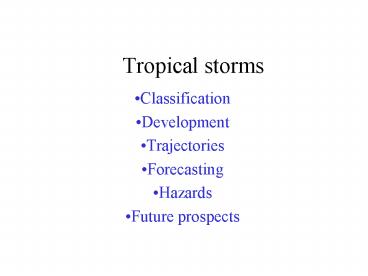Tropical storms PowerPoint PPT Presentation
1 / 67
Title: Tropical storms
1
Tropical storms
- Classification
- Development
- Trajectories
- Forecasting
- Hazards
- Future prospects
2
Tropical disturbances, etc.
3
Saffir-Simpson scale
4
Spawning areas for tropical storms (SST gt27C)
5
Tropical storm genesisconvergence behind an
easterly wave
In a typical hurricane season some 60 easterly
waves develop in the North Atlantic. Only about
1 wave in 5 becomes a tropical depression.
Strong upper level troughs and westerly winds
commonly suppress hurricane formation
6
Mature hurricane
Development fostered by release of heat from
condensed water in bands of clouds around the
tropical storm centre more rapid convergence and
updrafts. This ve feedback leads to
intensification and hurricane formation.
7
Structure of Hurricane Gilbert(Doppler radar
cross-section )
8
The Atlantic hurricane season(Dr. William Gray _at_
Colorado State U.)
Strong Azores High inhibits hurricanes
Strong El Niño suppresses hurricanes (but 1998?)
Wet springs inhibit hurricanes
Strong stratospheric easterlies suppress
hurricanes
Low SSTs inhibits hurricanes
9
Atlantic hurricanes(1995 season)
10
Tracks of typhoons affecting the China Sea region
11
Tracks of cyclones in the northern Indian Ocean
12
Effects of travelling high and low pressure
systems on hurricane paths
13
Hurricane Andrew (1992)
14
Hurricanes - examples of unpredictability
15
(No Transcript)
16
(No Transcript)
17
Forecasting
- NHC (Miami) uses nine tracking and intensity
models to forecast hurricane movement. - Seven models based on global climate forecasts
two (NHC90/91 and CLIPER) based on statistical
analyses of past hurricane trajectories. - Forecasts are for 12h, 24h, 36h, 48h and 72h
ahead and are updated at 4h intervals. - Some models are used for early stages others
for late (i.e. close to landfall). - Average errors vary from ocean to ocean,
depending on typical recurvature (Atlantic errors
are large)
18
Mean error (nm) for Atlantic hurricanes (1996-97
seasons)
Forecast model
19
The geography of forecasting error
72 h
48 h
24 h
20
Estimated annual deaths from hurricanes in the USA
21
Damages from hurricanes in the USA ( billions)
22
Hurricane hazards
Storm surge (5-6m common) High winds (see
Saffir-Simpson) Intense rainfall
X
New Orleans (-2m elev.) 72h to evacuate 1.6M
residents. Old and poor (100 000) who rely on
public transport present a major problem.
Solution move them to high floors of
skyscrapers?
Increasing population at risk (80 of residents
of Florida 8M people live within 8 km of coast
3M within storm surge zone)
23
El Niño events and tropical storm activity(e.g.
1998 El Niño)
- PACIFIC OCEAN - 14 tropical storms in E. Pacific
9 developed into hurricanes. - ATLANTIC OCEAN - 14 tropical storms 10 developed
into hurricanes.H. George most powerful storm
in 200 yrs hit Puerto Rico, Virgin Is.,
Domincan Rep., Florida and US Gulf coast -
300 deaths, 5G in damage.H. Mitch most
destructive storm in 200 yrs hit Nicaragua -
Guatemala - gt13 000 dead or missing, 5G in
damage.
24
Global warming and tropical storm activity
- Emanual (MIT) forecasts1. that the hurricane
season will be extended by 2 months or more
in the North Atlantic and Caribbean. 2.
that hurricane intensity will increase by
more than 50 - attaining maximum wind
speeds of gt300 km/h (cf. gt200 km/h at
present).
25
HURRICANE SEASON 2001
12 - 7 - 3
12 NAMED STORMS
7 HURRICANES
3 MAJOR STORMS
26
1995-2000 MOST ACTIVE 6 YEARS ON RECORD
79 NAMED STORMS
49 HURRICANES
24 MAJOR STORMS
27
(No Transcript)
28
(No Transcript)
29
(No Transcript)
30
PB4Y-2 PRIVATEER(Hurricane Hunter)
Lost, Hurricane JANET - 1955
31
COSMOSPHERE-HURRICANESUN PROVIDES HEAT
32
(No Transcript)
33
(No Transcript)
34
(No Transcript)
35
ATMOSPHERE-HURRICANE
36
TEMPERATURE
SST 26.5C OR MORE
TO A LEAST 46 METERS
DEEP
37
(No Transcript)
38
INFLOW-OUTFLOW
WARM/MOIST
CORIOLIS
SHEAR
39
WINDS
155 MPH 100 lbs per SQUARE FOOT.
SURGE
CUBIC YARD SALT WATER 3/4 TON.
40
HYDROSPHERE-HURRICANEOCEAN PROVIDES MOISTURE
41
(No Transcript)
42
(No Transcript)
43
BIOSPHERE-HURRICANEHABITAT DAMAGE
44
(No Transcript)
45
(No Transcript)
46
Board Growing in a TreeHurricane Andrew, 1992
47
ANTHROPOSPHERE/GEOSPHERE-HURRICANEA-SPHEREDEA
TH DISTRUCTION
48
FLORIDA KEYS
1935
49
FLORIDA KEYS 1935
50
CAMILLE
1969
51
RICHELIEU APTS. PASS CHRISTIAN
HURRICANE CAMILLE
52
AFTER CAMILLE
HURRICANE CAMILLE
53
American Legion Post, Bay St. Louis
CAMILLE
54
Hurricane Andrew, 1992
55
(No Transcript)
56
ERIN
1995
57
OCEANOGRAPHY 101 by ERIN
58
(No Transcript)
59
(No Transcript)
60
FLOYD ANDREW
1999
1992
61
WC-130 USAF(RES) HURRICANE HUNTER
62
AIRCRAFT RADAR
63
(No Transcript)
64
(No Transcript)
65
(No Transcript)
66
(No Transcript)
67
THE BIG ONE IS STILL OUT THERE

